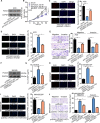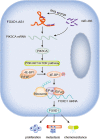FOXD1-AS1 regulates FOXD1 translation and promotes gastric cancer progression and chemoresistance by activating the PI3K/AKT/mTOR pathway
- PMID: 32460412
- PMCID: PMC7782086
- DOI: 10.1002/1878-0261.12728
FOXD1-AS1 regulates FOXD1 translation and promotes gastric cancer progression and chemoresistance by activating the PI3K/AKT/mTOR pathway
Abstract
Gastric cancer (GC) is a common gastrointestinal cancer with a high global mortality. Recent reports have suggested that long noncoding RNA (lncRNA) are implicated in multiple aspects of GC, including pathogenesis, progression, and therapeutic response. Herein, we investigated the function of FOXD1-AS1 in GC progression and chemoresistance. Expression of FOXD1-AS1 was low in normal stomach tissues but was upregulated in GC cell lines. Silencing of FOXD1-AS1 impaired GC cell proliferation and motility in vitro, and repressed tumor growth and metastasis in vivo. Importantly, FOXD1-AS1 upregulation increased the resistance of GC cells to cisplatin. Moreover, we found that FOXD1-AS1 promoted FOXD1 protein translation through the eIF4G-eIF4E-eIF4A translational complex. We also demonstrated that FOXD1-AS1 released eIF4E from phosphorylated 4E-BP1 and thereby strengthened the interaction of eIF4E with eIF4G by activating the PI3K/AKT/mTOR pathway. Activation of the PI3K/AKT/mTOR pathway was due to the post-transcriptional upregulation of PIK3CA, in turn induced by FOXD1-AS1-mediated sequestering of microRNA (miR)-466. Furthermore, we verified that FOXD1-AS1 facilitated GC progression and cisplatin resistance in a FOXD1-dependent manner. In conclusion, FOXD1-AS1 aggravates GC progression and chemoresistance by promoting FOXD1 translation via PIK3CA/PI3K/AKT/mTOR signaling. These findings highlight a novel target for treatment of patients GC, particularly patients with cisplatin resistance.
Keywords: FOXD1; FOXD1-AS1; PI3K/AKT/mTOR pathway; eIF4G-eIF4E-eIF4A translational complex; gastric cancer.
© 2020 The Authors. Published by FEBS Press and John Wiley & Sons Ltd.
Conflict of interest statement
The authors declare no conflict of interest.
Figures








Similar articles
-
Long noncoding RNA OIP5-AS1 causes cisplatin resistance in osteosarcoma through inducing the LPAATβ/PI3K/AKT/mTOR signaling pathway by sponging the miR-340-5p.J Cell Biochem. 2019 Jun;120(6):9656-9666. doi: 10.1002/jcb.28244. Epub 2018 Dec 11. J Cell Biochem. 2019. PMID: 30548308
-
Knockdown of long non-coding RNA HOTAIR inhibits cisplatin resistance of gastric cancer cells through inhibiting the PI3K/Akt and Wnt/β-catenin signaling pathways by up-regulating miR-34a.Int J Biol Macromol. 2018 Feb;107(Pt B):2620-2629. doi: 10.1016/j.ijbiomac.2017.10.154. Epub 2017 Oct 26. Int J Biol Macromol. 2018. PMID: 29080815
-
Long noncoding RNA TMPO-AS1/miR-126-5p/BRCC3 axis accelerates gastric cancer progression and angiogenesis via activating PI3K/Akt/mTOR pathway.J Gastroenterol Hepatol. 2021 Jul;36(7):1877-1888. doi: 10.1111/jgh.15362. Epub 2021 Feb 12. J Gastroenterol Hepatol. 2021. PMID: 33295056
-
The long noncoding RNA CRAL reverses cisplatin resistance via the miR-505/CYLD/AKT axis in human gastric cancer cells.RNA Biol. 2020 Nov;17(11):1576-1589. doi: 10.1080/15476286.2019.1709296. Epub 2020 Jan 7. RNA Biol. 2020. PMID: 31885317 Free PMC article. Review.
-
Targeting the translational apparatus to improve leukemia therapy: roles of the PI3K/PTEN/Akt/mTOR pathway.Leukemia. 2011 Jul;25(7):1064-79. doi: 10.1038/leu.2011.46. Epub 2011 Mar 25. Leukemia. 2011. PMID: 21436840 Review.
Cited by
-
Comprehensive analysis of ZFPM2-AS1 prognostic value, immune microenvironment, drug sensitivity, and co-expression network: from gastric adenocarcinoma to pan-cancers.Discov Oncol. 2022 Apr 13;13(1):24. doi: 10.1007/s12672-022-00487-0. Discov Oncol. 2022. PMID: 35416526 Free PMC article.
-
Current Insights into the Role of UV Radiation-Induced Oxidative Stress in Melanoma Pathogenesis.Int J Mol Sci. 2024 Oct 30;25(21):11651. doi: 10.3390/ijms252111651. Int J Mol Sci. 2024. PMID: 39519202 Free PMC article. Review.
-
LncRNA CASC9 facilitates papillary thyroid cancer development and doxorubicin resistance via miR-28-3p/BCL-2 axis and PI3K/AKT signaling pathway.J Cardiothorac Surg. 2024 Nov 13;19(1):629. doi: 10.1186/s13019-024-03129-4. J Cardiothorac Surg. 2024. PMID: 39538340 Free PMC article.
-
Identification of transcription factors associated with the disease-free survival of triple-negative breast cancer through weighted gene co-expression network analysis.Cytojournal. 2024 Dec 23;21:71. doi: 10.25259/Cytojournal_127_2024. eCollection 2024. Cytojournal. 2024. PMID: 39917004 Free PMC article.
-
Dysregulated Signalling Pathways Driving Anticancer Drug Resistance.Int J Mol Sci. 2023 Jul 30;24(15):12222. doi: 10.3390/ijms241512222. Int J Mol Sci. 2023. PMID: 37569598 Free PMC article. Review.
References
-
- (2015) Cancer cells require eIF4E to translate pro‐oncogenic mRNAs. Cancer Discov 5, 792.
-
- Chen X, Chen Z, Yu S, Nie F, Yan S, Ma P, Chen Q, Wei C, Fu H, Xu T et al (2018) Long noncoding RNA LINC01234 functions as a competing endogenous RNA to regulate CBFB expression by sponging miR‐204‐5p in gastric cancer. Clin Cancer Res 24, 2002–2014. - PubMed
Publication types
MeSH terms
Substances
LinkOut - more resources
Full Text Sources
Medical
Miscellaneous

